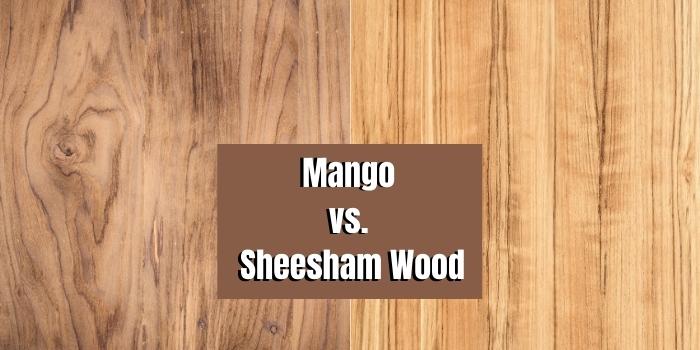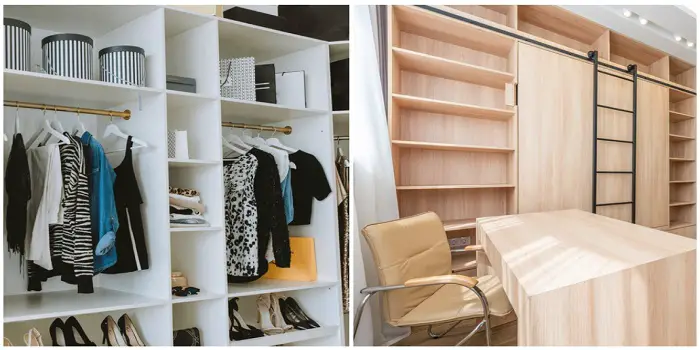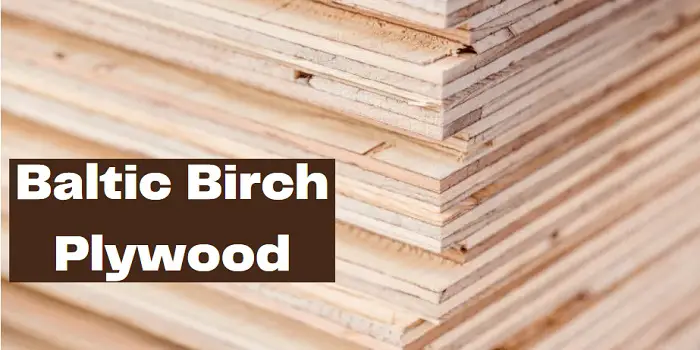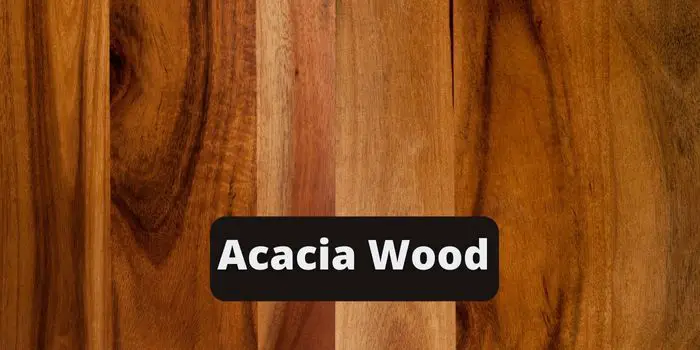
Acacia is the hardest wood in its class, outshining other hardwoods with its high density and pliability.
The orientation of Acacia’s fibers is multidirectional, meaning that they intersect.
Its core boasts a rich reddish-brown color accented by dark veins, while the sapwood typically ranges from light yellow to brown.
Acacia wood also has exceptional resistance to friction and a wide range of weather conditions. Its robust resistance to harsh elements and natural toughness make it an excellent choice for outdoor projects.
Furthermore, it is regarded as the finest substitute for exotic woods. However, because it fractures easily, this wood necessitates particular care, including a moderate drying regimen.
Now that you know Acacia wood’s characteristics, let’s explore some of its most popular uses and types, along with its benefits and drawbacks, in our article below…
Acacia Wood Uses
Acacia timber has been used traditionally by aboriginal Australians for hundreds of years.
It’s still one of the most versatile woods that can be used for a variety of purposes, both indoor and outdoor.
Popular indoor uses for Acacia wood include:
1- Flooring: Acacia is an ideal wood for flooring because of its high density. It is also scratch and dent-resistant, making it an excellent choice for high-traffic areas.
2- Furniture: Acacia wood furniture is becoming increasingly popular due to its unique grain pattern and durability. It is often used for coffee tables, chairs, end tables, bistro sets, and dining room furniture.
3- Cabinets and Kitchenware: Acacia wood cabinets are a beautiful and unique addition to any kitchen.
Not only that, but you can also use acacia wood to make various kitchenware items such as cutting boards, serving trays, and utensils.
4- Decorative Items: Acacia wood can be crafted into various home decor items such as picture frames, wall art, and vases.
If you are into carving and crafting, you can use acacia wood to create beautiful and unique pieces.
Outdoor uses for Acacia wood include:
5- Decking: Acacia is a popular choice for decking material due to its durability and resistance to rot.
6- Fencing: Acacia wood fencing is a great way to add privacy and security to your home.
7- Siding: Acacia wood siding is a beautiful and unique alternative to traditional siding materials.
Acacia Wood Types
Acacia wood is a hardwood tree found in Africa and Australia, made up of more than 1,200 species.
Some acacia trees can also be found throughout Asia, Pacific Islands, and North America.
The following are some of the most prominent acacia wood types you can find for your projects.
- Acacia Koa (Hawaii Koa)
- Acacia Acuminata (mangart and jam)
- Acacia Auriculiformis (earpod wattle, acacia auriculiformis)
- Acacia Mangium (Forest mangrove or black wattle)
- Acacia Melanoxylon (Australian Blackwood)
All these species of wood vary in hardness, density, and color. The hardness of the wood also ranges from very hard to soft.
So, based on your project requirements and preferences, you can choose the right type of wood that suits your budget.
Acacia Wood Advantages
Acacia wood, unquestionably, is one of the most popular woods in the world today. This popularity is due to its distinctive qualities and capabilities.
That said, acacia has advantages and drawbacks like every other wood. So, let’s get into them by discussing the pros first…
1- Sustainable
As there are over 1,200 species of acacia trees, it’s easy to find acacia wood no matter where you live.
This also means that different species can grow in different parts of the world and prevents rarer species from becoming extinct.
2- Antibacterial
The other benefit is unlike other woods, acacia is antibacterial by nature. This means that it may be safely used to process and serve meals.
If you’re searching for the finest wood piece to use as a chopping board or other items in your kitchen, acacia is the safe way to go.
3- Excellent Workability
Many types of acacia wood are often quite flexible when freshly cut, which allows you to mold the wood into different items easily.
Once these objects have been created, they become strong and sturdy. Thus, acacia is a perfect match for outdoor furniture such as benches and chairs or flooring with decorative art.
4- Unique Colors and Grains
Acacia wood is famous for its unique colors, from pale yellow to dark brown, and beautiful grains.
The exciting thing is that no two boards of acacia wood are the same, which makes each piece quite unique.
Depending on the growing location and cutting style, the color and grain of each acacia wood plank can differ significantly; you can pick and use the one that goes with your project’s style.
5- Robust and Water Resistant
Acacia wood is one of the most durable woods available on the market. It’s also highly water-resistant and rugged so that you can use the timber pieces in places constantly in contact with water.
6. Scratch Resistant Smooth Finish
Acacia wood is extremely tough; it does not get scratched easily. As a result, you won’t have to worry about your costly furniture being damaged.
If the furniture gets scuffed, all you have to do is apply a little touch-up paint.
Acacia wood is also unique in its smooth finish, making it ideal for doors and furniture.
Furthermore, this type of wood can last for decades and doesn’t require consistent polishing or treatment, saving you time and money in the long run.
7- Ideal for Long as Well as Short Items
Because some acacia trees can grow up to 100 feet tall, the wood is available in long and short lengths.
This means that whether you need a long bench or a small chair with hands and legs, you’ll be able to discover the perfect size of acacia wood.
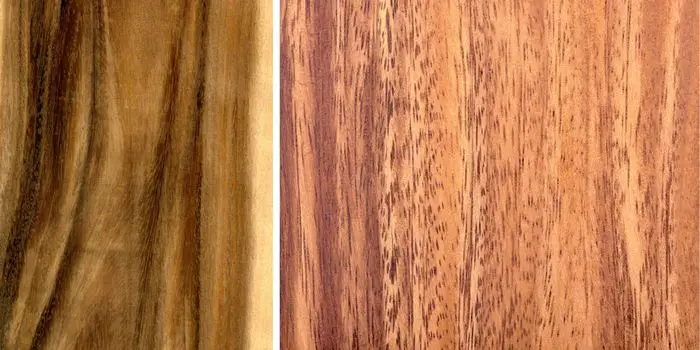
Disadvantages of Acacia Wood
Acacia wood has several disadvantages you should consider before deciding to use it for your project. Some of these include…
1- Acacia is Expensive
Remember that “expense” is always relative to your budget. You’ve probably come across websites that claim acacia wood is “affordable.”
So, what’s the real story?
Well, in my opinion, it all depends on the size and quality of the piece you need. For example, a small acacia wood cutting board may cost anywhere from $15 to $25.
On the other hand, a large acacia wood dining table with chairs can set you back a few thousand dollars.
Also, keep in mind that the price of acacia wood has been steadily increasing over the past few years in the exotic market due to the wood’s growing popularity.
Overall, acacia wood is more affordable than mahogany and rosewood, but if you compare it to American hardwoods like maple or oak, acacia will be pricier.
2- Sensitive to High Temperature
Acacia wood is durable; however, over-exposure to heat can slowly damage the fibers and make the wood more brittle.
For example, the wood will often crack or bow when you expose acacia furniture to direct sunlight or place it too close to a fireplace or heater.
This usually results in disaster if you have invested heavily in your acacia wood outdoor furniture.
3- Susceptible to Darkening
If you have placed warm dishes on your acacia furniture, you will notice the darkening effect below the dish.
This is generally because – if acacia wood is exposed to air and light, it darkens over time.
To prevent this issue, it’s best to turn your furniture regularly to ensure that every nook of the furniture is equally exposed to light and air.
4- Prone to Splitting and Crumble
Acacia wood must be dried under special drying conditions because it is susceptible to bending or breaking if not properly dried.
As a result, if you reside in a location with little moisture, you must ensure that your acacia furniture does not dry out or become brittle.
5- Irregular Grain Structures that can Scratch
One of the crucial disadvantages of acacia wood is its uneven grain structure. Many people enjoy twists and knots in wood; however, the grain structure does not appeal to everyone.
The irregularities in the grain can make acacia wood’s design unpredictable. If you’re concerned about your home’s appearance, this unpredictable nature of the wood can be a drawback.
Furthermore, some acacia wood grain structures will get scratches that tend to go against the grain.
Unfortunately, these scratches are difficult to remove, and even a significant touch-up isn’t always enough.
The only way to get rid of these marks is to redraw the grain markings, which is not an easy task.
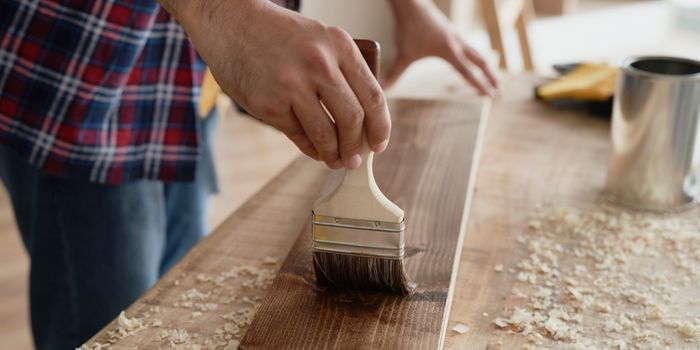
Caring, Maintenance, and Buying Tips
Acacia wood can be stained, painted, or left in its natural state. Indoors it can last for decades if left untreated.
The appropriate wood preservative, however, may help treat your acacia furnishings depending on the location of usage – if you plan to use it outdoors.
Read the directions on the preservative label before applying it to your furniture.
Also, use the proper shine once in a while to refresh the gloss of your acacia furniture, using products to restore its sheen.
When using any paint, stain, or varnish, it’s best to experiment on a small, hidden furniture area before finishing the entire piece.
When it comes to maintenance, acacia wood doesn’t require complex procedures. Cleaning it once in a while with soap and water is enough.
However, if your acacia furniture is near a swimming pool, it must be cleaned regularly to minimize the impact of chlorine-rich water from the pool.
If you plan to buy, acacia wood is originally from Australia, but it has since spread to Africa, Europe, Asia, and North and South America.
If you can’t find it at a store near you, importing from these places is always an option.
Always consult a professional to get the best advice on caring for and buying acacia wood furniture when in doubt. They can give you more tips on what to do and avoid.
Final Thoughts
Acacia wood furniture and floors for your home and commercial spaces are an excellent investment because it’s a beautiful and versatile material.
However, remember that it’s not indestructible and will require some care.
So, take the proper precautions to protect your flooring and furniture with all the pros and cons of acacia wood mentioned above in mind.
Share the post "Acacia Wood – Characteristics, Uses with Pros and Cons"

Hi, I am Mark Garner a professional carpenter, woodworker, and DIY painter. I live in the small city of Peoria, Arizona as a semi-retired woodworker. I have started this blog with a simple motive to help you with my wood experience in this sector. If you like to know more about what I love doing and how it all got started, you can check more about me here.


